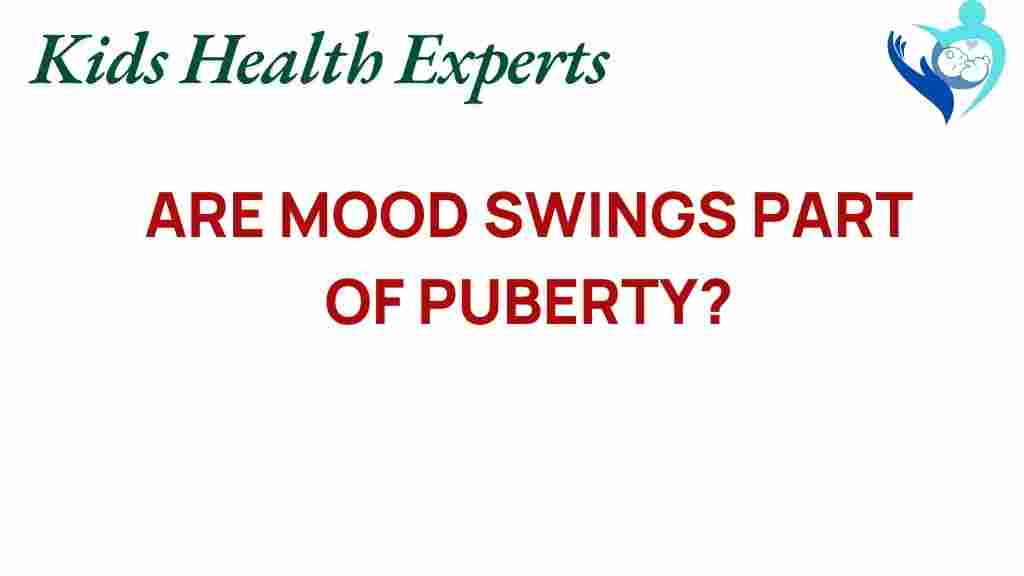Understanding Mood Swings: Are They an Inevitable Part of Puberty?
Mood swings are a common experience during puberty, a time of significant change in the lives of adolescents. As young people transition from childhood to adulthood, they undergo various emotional changes that can sometimes be confusing and overwhelming. Understanding the connection between mood swings and puberty is essential for parents, educators, and the teenagers themselves. This article will explore the nature of mood swings during adolescent development, the role of hormonal fluctuations, and how these factors impact mental health and emotional well-being.
The Nature of Mood Swings in Adolescence
Mood swings can be defined as rapid and intense changes in emotional states. During puberty, adolescents may experience heightened emotions ranging from extreme happiness to deep sadness within short periods. These fluctuations are often influenced by biological, psychological, and social factors.
Here are some common characteristics of mood swings during puberty:
- Increased Intensity: Emotions may feel more intense than they did in childhood.
- Rapid Changes: Feelings can shift quickly, sometimes without clear reasons.
- Social Influences: Peer relationships and social dynamics play a significant role in emotional states.
Hormonal Fluctuations and Their Impact
One of the primary causes of mood swings during puberty is hormonal fluctuations. As adolescents grow, their bodies produce increasing levels of hormones such as estrogen, testosterone, and progesterone. These hormones are crucial for physical development but also significantly influence mood and behavior.
The impact of hormonal fluctuations on mood swings includes:
- Increased Sensitivity: Hormones can heighten sensitivity to stress and emotional experiences.
- Impulsivity: Adolescents may act more impulsively due to hormonal changes affecting their decision-making processes.
- Emotional Regulation: Hormonal shifts may make it harder for teenagers to regulate their emotions effectively.
Emotional Changes During Puberty
Puberty brings about significant emotional changes that can lead to mood swings. These emotional changes are part of the adolescent development process and can include:
- Identity Exploration: Adolescents are often searching for their identity, which can lead to feelings of confusion and uncertainty.
- Increased Self-Awareness: As they become more self-aware, they may feel more vulnerable to criticism and rejection.
- Peer Pressure: The desire to fit in can lead to stress and anxiety, contributing to mood swings.
Understanding Teenage Behavior
Teenage behavior is often characterized by a desire for independence, exploration, and self-expression. However, this quest for autonomy can result in conflicts with parents and authority figures, exacerbating mood swings. Understanding these behaviors can help adults provide better support for adolescents experiencing emotional turbulence.
Some common teenage behaviors associated with mood swings include:
- Rebellion: Teens may push back against rules or expectations as they seek independence.
- Withdrawal: Some adolescents may isolate themselves during difficult emotional periods.
- Overreaction: Minor issues can lead to disproportionate emotional responses.
Supporting Emotional Well-Being During Puberty
Supporting a teenager’s emotional well-being during puberty is crucial for healthy adolescent development. Here are some strategies for parents and caregivers:
- Open Communication: Encourage open discussions about feelings and experiences.
- Active Listening: Show empathy and understanding when teens express their emotions.
- Promote Healthy Coping Mechanisms: Teach strategies for managing stress, such as exercise, mindfulness, or creative outlets.
Additionally, it can be beneficial to maintain a routine, as stability can help mitigate mood swings.
When to Seek Professional Help
While mood swings are a normal part of puberty, there are times when they may indicate a more serious issue. Parents and caregivers should be aware of signs that may warrant professional help, including:
- Persistent Sadness: If mood swings are accompanied by prolonged feelings of sadness or hopelessness.
- Changes in Behavior: Significant changes in appetite, sleep patterns, or social withdrawal.
- Thoughts of Self-Harm: Any indications of self-harm or suicidal thoughts should be taken seriously and addressed immediately.
If you notice these signs, consider reaching out to a mental health professional who specializes in adolescent developmental issues. Resources such as mental health hotlines can provide immediate assistance and guidance.
Common Misconceptions About Mood Swings
There are several misconceptions about mood swings during puberty that can contribute to misunderstandings about adolescent behavior. Some of these include:
- Mood Swings Are Just “Teenage Drama”: While mood swings can seem dramatic, they are often rooted in real emotional challenges.
- All Mood Swings Are Bad: Some mood changes can be positive and lead to personal growth and self-discovery.
- Parents Don’t Understand: While it may seem that parents cannot relate, many have experienced similar feelings during their own adolescence.
Conclusion
Understanding mood swings during puberty is essential for supporting adolescents as they navigate this challenging period of development. Hormonal fluctuations, emotional changes, and teenage behavior all contribute to the experience of mood swings. By fostering open communication, promoting emotional well-being, and recognizing the signs that may require professional help, parents and caregivers can play a vital role in guiding teenagers through their emotional landscapes.
Ultimately, mood swings are a normal part of the adolescent experience. With the right support and understanding, teenagers can learn to manage their emotions effectively, paving the way for a healthier transition into adulthood. For more information on adolescent mental health, please visit this resource.
This article is in the category Mental and created by KidsHealthExperts Team
